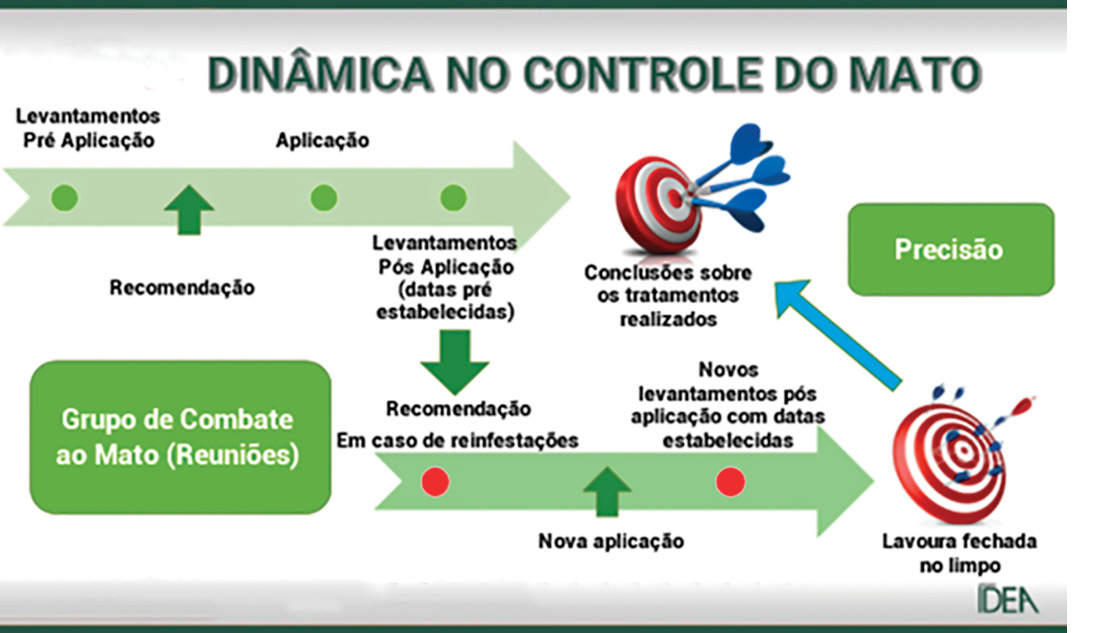Dib Nunes Junior
Diretor do Grupo IDEA
OpAA73
O controle de plantas daninhas em grandes lavouras
Com as atuais altas de preços dos insumos agrícolas, as empresas precisam pensar na maximização, numa gestão bastante rigorosa de uso desses produtos, de modo a obter os melhores resultados no combate a pragas, doenças e plantas daninhas nos canaviais.
No caso do combate ao mato, para evitar erros em recomendações e desperdícios de produtos aplicados, é necessário realizar uma detalhada análise técnica da situação para direcionar corretamente os defensivos para hora, lugar e alvos certos.
Uma das maiores dificuldades que os produtores enfrentam para combater esses problemas é administrar todas as atividades de controle de plantas daninhas nas extensas lavouras de cana-de-açúcar. As invasoras se disseminam com espantosa rapidez e estão se mostrando cada vez mais agressivas e adaptadas aos diferentes ambientes de produção. Ao menor descuido, concorrem com a cana, chegando a roubar mais da metade da produção em apenas alguns meses de matocompetição.
Os produtores, de forma geral, enfrentam esse grave problema sem muita organização, e o que se observa é bater o desespero quando a situação fica crítica no período quente e úmido do ano. Basta não acompanhar de perto a lavoura e pronto, o produtor é surpreendido com vigorosas infestações de plantas daninhas que rapidamente sufocam as novas brotações, concorrendo por água, luz e nutrientes. O resultado desse problema é a queda na produtividade.
Em grandes áreas de cana, como as usinas, que cultivam milhares de hectares com canaviais em diferentes estágios de desenvolvimento esparramados por todo o lado, há uma grande diversidade e intensidade de plantas daninhas. A gestão de toda essa área não é uma tarefa fácil.
O controle de plantas daninhas exige dos técnicos muita atividade e vigilância o ano todo, sob ação de diversos fatores que variam de acordo com um importantíssimo componente: as mudanças climáticas nas quatro estações do ano.
 Além dos fatores climáticos, é importante também saber a hora certa de se fazer os levantamentos de ocorrência das plantas daninhas e, ao recomendar os herbicidas, considerar quais espécies de mato estão ocorrendo, a intensidade de infestação na área, além do estágio de desenvolvimento da cana. Também a camada de palha, o teor de argila e a matéria orgânica nos solos são importantes, pois ajudam na determinação das dosagens dos defensivos. Isso tudo, sem mencionar o sistema de pulverização que vai ser utilizado.
Além dos fatores climáticos, é importante também saber a hora certa de se fazer os levantamentos de ocorrência das plantas daninhas e, ao recomendar os herbicidas, considerar quais espécies de mato estão ocorrendo, a intensidade de infestação na área, além do estágio de desenvolvimento da cana. Também a camada de palha, o teor de argila e a matéria orgânica nos solos são importantes, pois ajudam na determinação das dosagens dos defensivos. Isso tudo, sem mencionar o sistema de pulverização que vai ser utilizado. Para completar as preocupações dos responsáveis pelo controle das plantas daninhas, eles ainda têm que considerar as características dos herbicidas, como o período residual (que, geralmente, não é muito longo), o modo de ação sobre as diferentes invasoras, a solubilidade no solo, o modo de ação sobre as invasoras etc.
Tudo isso precisa ser conhecido antes de se fazer a recomendação de produtos. Além de todo esse procedimento, ainda é necessário programar os levantamentos nas visitas de inspeção e nas operações realizadas antes, durante e depois dos tratamentos realizados.
Nessa atividade há uma grande variabilidade de situações e dezenas de interações entre fatores interferentes, ambiente e produtos aplicados a cada tratamento realizado, que geram centenas de informações. O que fazer com esse enorme volume de dados coletados e armazenados cotidianamente? É humanamente impossível processar essas informações, porém precisamos deles para responder a muitas importantes questões, como:
Quais foram os melhores produtos nas diferentes épocas do ano? Qual foi o período residual de cada produto e de suas misturas? Quais foram as principais plantas daninhas controladas? Quais foram os melhores produtos pré-emergentes na cana planta? E nas socas? Quais foram os melhores herbicidas para o controle em pós-emergência? E as aplicações em PPI? Foram eficazes? Houve necessidade de repasses ou catação? Quais produtos devemos colocar no portfólio de compras? Qual é a distribuição de plantas daninhas na lavoura (mapeamento)? Qual é o melhor método de levantamento para apurar ocorrência de daninhas e desempenho dos herbicidas utilizados? Como podemos nos organizar para não atrasar nenhum levantamento? Quais são os relatórios gerenciais que precisamos para realizar uma adequada gestão? Como agrupar dados para realizar as recomendações de herbicidas? Como organizar a dinâmica das Ordens de Serviço? Quais lições podemos tirar do controle que está sendo feito? Onde ainda precisamos melhorar?
Essas e outras questões precisam fazer parte do cotidiano dos tratos culturais e conduzir essa prática a um permanente aprimoramento. Como se vê, essa é uma atividade que exige muito mais do que uma simples recomendação de produtos. Hoje, temos no mercado pelo menos 50 moléculas de herbicidas registradas para cana-de-açúcar, cada uma com suas características e especificações de posicionamento, além das incontáveis misturas desses produtos. Como administrar tudo isso? Como fazer uma gestão baseada em melhoria contínua dos processos e dos conhecimentos? No trabalho de combate às plantas daninhas, temos várias etapas que precisam ser organizadas e pontualmente acompanhadas.
Faz-se necessário um agendamento com levantamentos em datas preestabelecidas para recolher informações de pré e pós aplicação dos herbicidas e, principalmente, para montar uma rotina de atuação.
Numa grande lavoura, vai existir, ao mesmo tempo sob vigilância, canaviais em diversos estágios da cultura que vão necessitar frequentes levantamentos de campo, consultas aos dados armazenados e estoques de produtos.
Com organização, pode-se conhecer, a todo momento, a real situação do mato em toda a lavoura e melhorar a programação de serviços, principalmente nas áreas de reforma (momento bom para “despraguejamento”). A grande quantidade de dados levantados precisa ser canalizada ao arquivo correto, processado com agilidade e disponibilizado quando da emissão das O.S., com as recomendações dos herbicidas adequados a cada situação.
São várias as fases e levantamentos de campo que devem ser efetivados antes e depois das aplicações de herbicidas. Para cada fase, relatórios com avaliação da situação precisam ser emitidos, com os mais diferentes retratos da situação de combate ao mato. Todo esse fluxo de dados e serviços deve seguir uma metodologia bem definida e prazos preestabelecidos para visitas de inspeção. Só assim os gestores terão toda a lavoura sob controle a qualquer momento do ano.
A solução é a utilização de um software especialista que facilite e processe toda essa gama de informações advindas diariamente da lavoura. Já temos disponível no mercado ferramentas dotadas de algoritmos processadores de dados, que emitem os relatórios certos para a gestão dessa atividade. Esses softwares estão sendo disponibilizados aos maiores produtores de cana-de-açúcar, cooperativas e, principalmente, às usinas que tem grandes extensões de áreas a tratar.
Portanto, utilizando todos esses conceitos e estratégias na gestão no combate ao mato é que será possível maximizar os significativos investimentos realizados, extrair o melhor dos herbicidas aplicados, ganhar continuamente informações sobre seu desempenho, e dessa forma, proteger os canaviais para alcançarem as melhores produtividades.




